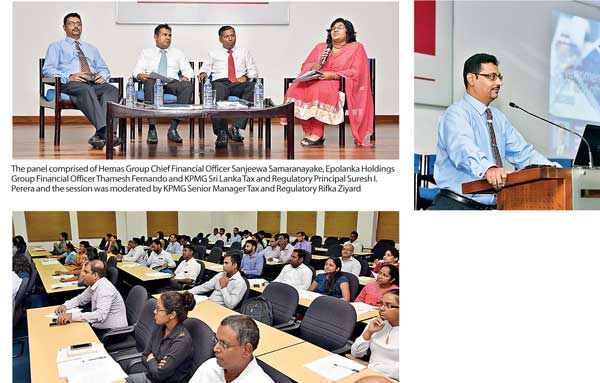05 Oct 2016 - {{hitsCtrl.values.hits}}

Chartered Institute of Management Accountants (CIMA) organised a seminar on the recent development in value-added tax (VAT) and other taxes recently at the CIMA auditorium. The presentation on the tax bills issued was delivered by KPMG Tax and Regulatory Principal Suresh I. Perera.
There are several bills that have been issued such as VAT, Nation Building Tax (NBT), Ports and Airport Development Levy and Land (Restrictions on Alienation) Act.
The VAT Bill issued dated September 13, 2016 contains the proposed changes to the rate of VAT, general threshold, threshold for wholesale and retail, limitation in certain exemptions, etc.
The VAT rate as per the bill will be 15 percent from the date of passing the act. The bill explains that during the period from May 2 to July 11, the VAT rate would be 15 percent, while from the date of July 11 to the date of passing the act the rate applicable would be 11 percent.
The significance of the date July 11 - that has been referred to in the bill - is the date the court issued the judgment in relation to the petition filed against the VAT amendments.
The general threshold has been reduced from Rs.3.75 million per quarter to Rs.3 million per quarter and the same is with effect from April 1, 2016.
The wholesale and retailers threshold will be Rs.12.5 million per quarter post the passing of the VAT Act. There seems to be ambiguity as to the threshold applicable for wholesale and retailers from May 2, 2016 to July 11, 2016.
However, post-July 11, 2016 and up to the date of enactment, the threshold applicable for wholesale and retail trade will be Rs.100 million per quarter, similar to the threshold applicable from January 1, 2015 to May 2, 2016.
The VAT amendment in 2014 introduced the concept of ‘deemed VAT’ with regard to persons supplying both liable products and exempt products.
The concept was to compel the supplier to pocket out VAT in relation to that part of the exempt supplies, which is over and above the 25 percent of the total supplies. The web notice suspended the provisions in relation to deemed VAT from January 1, 2016 but the bill suspends the deemed VAT from passing of the act.
While suspending the deemed VAT is a welcome move, it would eliminate many practical inconvenience if the effective date of the suspension is reconciled with the effective date stated in the web notice, i.e. January 1, 2016.
Deemed input credit
A concept of ‘deemed input credit’ has also been introduced to provide relief to wholesalers and retailers who transact with persons who issue a non-tax invoice (person unregistered for VAT). This concept enables the VAT registered wholesaler and retailer to claim input VAT on their supplies to non-VAT registered persons, thereby the burden on the VAT registered wholesaler and retailer.
The concept of deemed input credit is novel to the Sri Lankan VAT system and is not in line with the ‘invoice credit method’ that is followed by Sri Lanka. This provision has been introduced to provide relief to small-scale wholesalers and traders who are reluctant to enter the VAT net, due to the fear of not being able to claim input VAT from the non-registered suppliers.
However, the bill states that this would apply to wholesalers and retailers for any period commencing on or after May 2, 2016. Thereby even large-scale wholesalers and retailers can make avail of this relief, which may not be the intention of introducing such a provision.
An administrative provision has also been introduced for compulsory submission of schedules along with the VAT return. Non-submission of schedules is deemed not to have furnished the VAT return. A six-week period post the end of the taxable period is introduced to submit the complete schedules.
The bill includes restrictions/limitations for VAT exemptions in areas such as dairy, healthcare services, telecommunication services, supply of rental accommodation, etc. The NBT Bill was issued on August 19, 2016 and includes amendments to the threshold for chargeability. The threshold, which was at Rs.3.75 million per quarter, has been reduced to Rs.3 million with effect from April 1, 2016. The higher threshold of Rs.25 million per quarter, which was applicable for hotel, guest house, educational services, supply of labour, is removed as per the bill.
The threshold for processing of locally produced agricultural produce will continue to be Rs.25 million per quarter. NBT exemption on lubricant, telecommunication services and on supply of electricity has been removed.
The Port and Airport Development Levy Bill (PAL) issued on September 22, 2016 states that the rate of PAL will be 7.5 percent with effect from January 1, 2016. The gazette notification has been issued for the concessionary rate of 2.5 percent extended to certain electronic items.
The Land (Restrictions on Alienation) Act Bill issued on September 2, 2016 states that the land lease tax will not be imposed with effect from January 1, 2016.
The presentation was followed by a panel discussion with eminent personalities from the business sector. The panel comprised of Hemas Group Chief Financial Officer Sanjeewa Samaranayake, Epolanka Holdings Group Financial Officer Thamesh Fernando and KPMG Sri Lanka Principal Tax and Regulatory Suresh I. Perera. The session was moderated by KPMG Senior Manager Tax and Regulatory Rifka Ziyard.
27 Nov 2024 5 minute ago
27 Nov 2024 8 minute ago
27 Nov 2024 28 minute ago
27 Nov 2024 1 hours ago
27 Nov 2024 1 hours ago